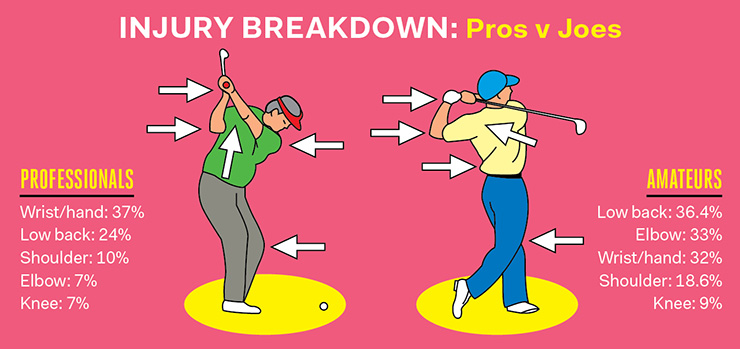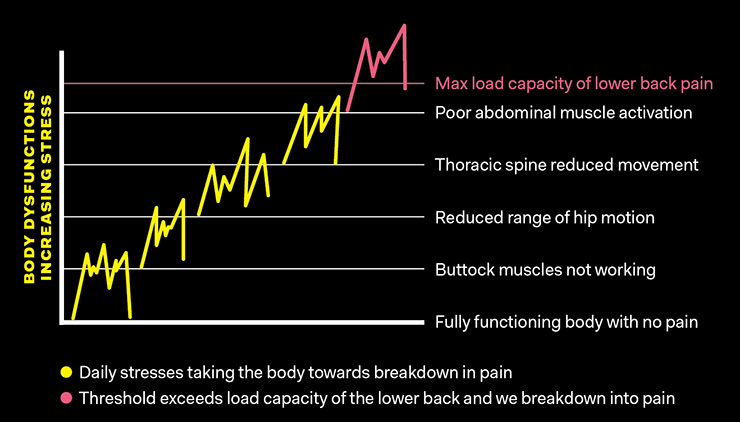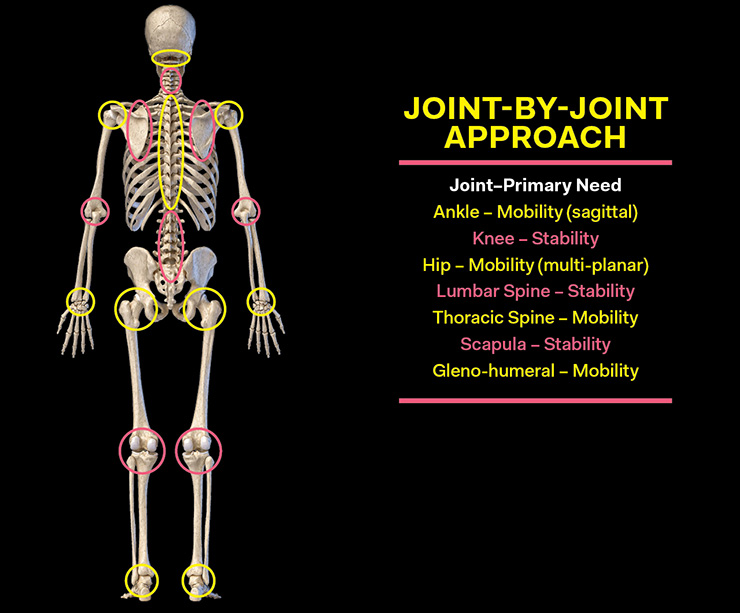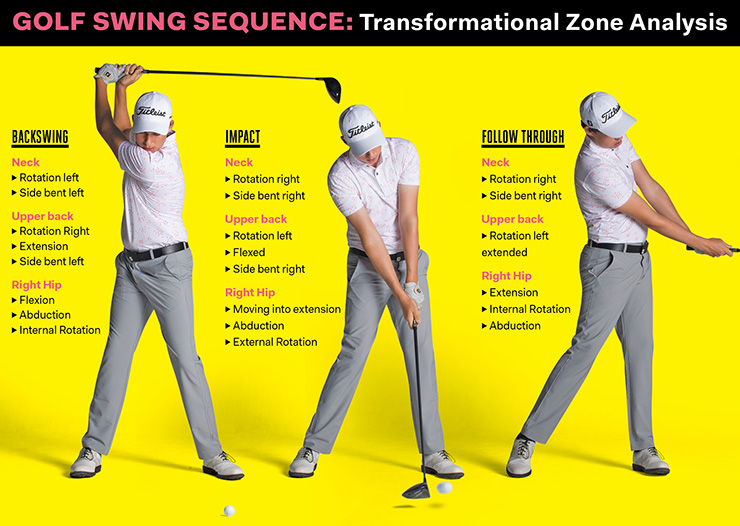Photo by Getty Images
The old adage warns to beware the injured golfer. Sure, but wouldn’t you much prefer to play on injury-free? If so, lend Russell Hill, the proud father of Middle East amateur No.1 Josh Hill, your attention. In the first of a two-part series, the osteopath specialising in golf at Optimal Fitness identifies the most common golf injuries, why and how they happen and how to prevent frustrating time on the sidelines.
Arnold Palmer once famously described golf as “…deceptively simple and endlessly complicated.” The same can be said for writing an article on golf injuries and trying to succinctly explain why they happen, what to do if you do get injured, how to prevent recurrence and importantly how best to avoid them altogether. My passion for keeping golfers on the fairways of the UAE means I’ll do my best to honour The King by summing up this complicated subject and offering simple solutions to playing on injury-free.
Perceived by outsiders as a gentle pursuit, golf is not a sport that many people associate with sports injuries. However, a study from the Centre for Injury Research and Policy in Columbus, Ohio shows that in the U.S. alone, the game is responsible for more than 30,000 emergency room visits every year. Research has also found that 35.2% of all golfers will have sustained an injury within the last 12 months and 69.7% of the injured golfers miss games and practice sessions due to the injury. Many injuries resulted in a forced absence of a least a month.
The game is still in the early stages of understanding injuries, strength and conditioning and injury prevention. It has come a long way in a short time, however, and continues to grow at a rate that is a challenging and fun to keep up with.
Amateur Aches
The spine, and particularly the lower back, account for the greatest overall incidence of injury (up to 36.4%) for amateur golfers. The elbow (up to 33%), the wrist and hand (up to 32%), and the shoulder (up to 18.6%) are the other most frequently injured sites for weekend warriors. Injuries to the lead side (left side for right-handed golfers) are five times more frequent than the trail side (84.5%)

A number of factors contribute to the common golf swing injuries:
• Over-swinging
• Poor body mechanics and suboptimal swing mechanics
• Poor conditioning
• Lack of flexibility
• Poor ground reaction forces
• Age
• Sitting in buggies
• Overuse and over-practice
• Not warming up the muscle/joints for the required movements properly
• Rotational stress placed on the spine, ankle, knees, hips and neck
• Incorrect grip and setup
• Traumatic force to the body resulting in a poorly executed swing
• Making swing changes that the body does not have the capacity to adapt to
• Intermittent Play
Published research concerning risk factor is of relative low quality but most golf injuries generally occur as a result of a joint, cartilage, muscle, ligament, fascia, tendon, bone or disc having to absorb more stress/strain than it can cope with at that particular moment in time.
To understand golf injuries and how to avoid them we first have to understand the mechanisms that predispose someone to these injuries. The golf swing is a highly explosive athletic movement that relies on the whole body moving in a powerful, fast and sequentially integrated fashion.
Movement occurs from the ground, to the feet and up into the knees, pelvis and spine and from the club head into the hands, through the arms, elbows, shoulders and into the spine. To allow this highly complex movement integration to occur effectively, each joint along the chain has to maintain its own mobility, flexibility, stability, and local/ global muscle strengths to sustain its individual integrity and function. If a joint in the chain is missing any one of these vital elements, the stress load will have to be absorbed by another structure. This structure might not have the ability to absorb this load effectively and this invariably leads to a breakdown into injury and pain.

Modern Curse
Lets look at a commonly occurring example of a sedentary worker who does not create much opportunity to exercise during the week, plays golf once or twice at the weekend and has the occasional back pain that stops him playing golf for a month or so a year. Long periods of sitting have a tendency to reduce range of motion in the ankles, hips and upper back and reduce strength and stability in those muscles that support the posture and stabilise movement.

If we compare this to the diagram (above) illustrating the Mike Boyle and Gary Cook mobility and stability continuum, you should notice as we work through the body the joints alternate between those joints that are mobile and those that are stable. By appreciating this we start to understand that the vital areas of movement in our example are starting to diminish. As golf is a rotational sport, if we have lost this movement in these areas we actually start to ask the lower back to absorb these additional stresses which it is not designed to do. In addition to movement/mobility dysfunctions with our sedentary lifestyle, we have the de-conditioning of the local and global musculature. This is important as muscles not only contract to provide the power to move but also work hard to decelerate movement and absorb much of the mechanical stress before it gets to the ligaments and joints. So if you have a joint under stress due to absorbing more movement than it is designed to, and an increased stress on all the local, ligaments, tendons, joint capsule, cartilage, fascia and bone as a result of the muscle unable to effectively distribute these stresses, it is only a matter of time before the body breaks down into pain.
You’re injured. What now?
If you do injure yourself, the best course of action is to consult a medical practitioner as soon as possible as the quicker these things are dealt with, the shorter the recovery will be. Far too often I see patients where the injury happened a few weeks earlier and they had left it to calm down because they thought it would get better on its own. That rarely transpires. In fact, the delay often makes it harder for the practitioner to help get you back out on the golf course quickly.
Like any medical consultation, the practitioner will go through a full case history covering the pain, the onset, the nature of the pain and past medical history. Then, if appropriate, they’ll run through the necessary medical and orthopaedic tests to come to a diagnosis, prognosis and treatment plan. The primary goal of treatment is to reduce pain and achieve full recovery of the injury. In addition, the practitioner has to fully assess and treat the mobility, flexibility, stability, and local/ global muscle strengths and weaknesses. Usually, the practitioner will demonstrate a number of exercises to help reduce the pain further and to start addressing the dysfunctions found.
Post treatment continuum that will help to reduce the reoccurrence of such issues include resolution exercises, rehab and restorative exercises before moving into strength and conditioning and the implementation of an effective pre-round warmup routine.
Warm-up
Research shows that 65 percent of all golfers do not perform a pre-round warm up. While the influence of a warm-up on injury prevention is unclear, the evidence suggests a positive effect.
The ‘RAMP’ approach can guide an effective warm-up:
RAISE body temperature, heart rate, respiration rate, blood flow and joint fluid viscosity
ACTIVATE key muscle groups
MOBILISE key joints and range of motion specific to the sport
POTENTIATE high-intensity dynamic exercises to mimic performance

Photo by Masam Ali
I would also highly recommend a golf movement assessment that breaks down and exposes the functions and dysfunctions in mobility, flexibility, stability and muscular strengths / weakness. Having identified these, an appropriate exercise program can be implemented and if you regularly exercise already, it can run in conjunction with any existing program if implemented skillfully. It is also important to have these reassessed at regular intervals to make sure that the desired results are being achieved and to reset a new program with new goals once the initial outcomes have been achieved.
Next month I’ll run through common injuries and how best to deal with them. Before then, a parting thought. One of the most common injuries in the UAE is sunburn. Please use suncream as manual therapy is not possible with sunburns.
A former professional squash player and coach, Russell Hill qualified from the British School of Osteopathy at the age of 27. With his MENA Tour playing son Josh Hill, the world record holder as the youngest winner of an official WAGR event, developing into one of the hottest prospects in English golf, Russell has spent the past decade furthering his education to specialise in golf injury prevention, treatment, movement assessments, rehab and golf fitness. Hill Snr not only treats local golf enthusiasts but is the official provider to the MENA tour and treats European and LET players when they’re passing through the UAE.









